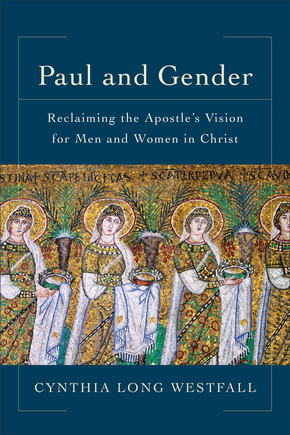
BOOK REVIEW: PAUL AND GENDER
Honored by the Council for Biblical Equality (CBE) with a Lifetime Achievement Award in 2017, Cynthia Long Westfall is a New Testament scholar known for her linguistics work. She is the author of several books, including Paul and Gender: Reclaiming the Apostle’s Vision for Men and Women in Christ“>Paul and Gender: Reclaiming the Apostle’s Vision for Men and Women in Christ, and an assistant professor of New Testament at McMaster Divinity College. I met Ms. Westfall after she slipped into the chair beside me at an academic conference. At the end of the session, we had a lengthy talk about Bible women and the Greek text. I found her to be knowledgeable and passionate about constructing a coherent and comprehensive Pauline theology of gender. And, I gathered that her conclusions on women’s veiling are quite firm.
Westfall’s commendable book, Paul and Gender: Reclaiming the Apostle’s Vision for Men and Women in Christ“>Paul and Gender, significantly contributes to the evangelical gender conversation through insightful research and interpretations of the contested “women passages.” Also, she utilizes an overarching interpretive framework that includes ancient culture’s gender stereotypes, calling, the body, authority, creation, fall, and eschatology. Written for academics, each of the nine chapters is lengthy, with highly concentrated research, exegetical interpretations. She employed a variety of methodological lenses to view the biblical text. Non-academics, however, will also benefit from the book.
Challenging Traditional Interpretations
She challenges and exhorts her readers, especially complementarian readers. She states, “The traditional interpretations and understandings of the Pauline theology of gender should not be guarded as a citadel and treated as a privileged reading of the texts that must be incontrovertibly proved wrong…I invite serious scholars and students of the text to go through the discipline of carefully identifying the information, assumptions, and inferences that have been imported into the texts, extract them from the reading, and then read the texts again with hermeneutics that are consistent with the best practices for interpreting biblical texts and language in general (p. 314).” To understand the Bible passages related to gender, Westfall rightly argues one must apply the same hermeneutics to women as are applied to men.
Scholars agree that the Greco-Roman culture impacted the early church in many significant ways. And, the book includes cultural contexts impacting gender relations, such as honor and shame, reciprocity, and the patron-client relationship. One must discern whether Paul writes espousing compliance with the cultural norms for women, or to subvert them.
Westfall includes extensive footnotes, a select bibliography, and four distinct indexes. I have linked a chapter-by-chapter review by an egalitarian and a complementarian here: Thomas R. Schreiner (complementarian), and Nicholas Quient (egalitarian).
Four significant arguments in Paul and Gender
- In Chapter 3, “Creation,” Westfall provides a strong argument against “creation order” as a transcendent norm. “Confessional traditions agree that all Scripture, including the creation account, is useful for reproof and correction (2 Tim 3:16), which includes specific applications to problems that are limited to situations and culturally bound issues. Therefore, any assumption that a citation of the creation account must indicate a transcendent norm is a problematic presupposition…is inconsistent with the best evangelical hermeneutic and homiletic traditions, which attempt to find relevant, fresh, and specific applications of scriptural norms for their contexts in every sermon (p. 62–63).”
- In Chapter 5, “Eschatology,” Westfall argues against the complementarian argument (Thomas Schreiner) for the “priority of Adam,” and argues for “shared dominion,” as a transcendent norm for men and women. “According to Paul, there is no differentiation in humanity’s destiny on the basis of gender, race, or status. Women, as well as gentiles and slaves, have a shared destiny of authority and rule. If this is consistent with the purposes of God at the foundation of the world, with the creation of Adam and Eve, and with the new creation in Christ, then women could not have been created to be subject to men. In other words, women cannot have a final destiny that was not their intended purpose or function at creation.” (p. 147)
- In Chapter 5, “Eschatology,” she records that the traditional view often argues for male church leadership, and against women as pastoral leaders, because Jesus was male. Westfall refutes this argument by pointing out that there is no biblical passage stating only males may represent Christ. And, because Paul pointed to the resurrection as the foundation for eternal hope—the resurrection signifies that all believers will share in Christ’s life, his inheritance, his power, and his body. “It follows that our representation of the resurrected Christ in ecclesial rituals or leadership is not biblically linked to our current condition of our mortal bodies…There is no priority or entitlement for men and no hint of any primogeniture in gender relationships in Pauline eschatological fulfillment (p. 150).”
- In Chapter 7, “Calling,” Westfall writes that scholars concur that Paul wrote 1 Timothy nine years or more after 1 Corinthians. Therefore, context and the Greek words used for “silence” and “submission” are a priority in interpreting 1 Corinthians, and not the “prohibitions” of 1 Timothy.
Westfall’s arguments are well-worth wrestling with. Though, I do not concur with her premise that Paul was telling women leaders in the church at Corinth to veil while praying and prophesying. It would be interesting to hear Westfall and Lucy Peppiatt, author of ” data-wplink-url-error=”true”>Women and Worship at Corinth, engage in a debate on 1 Corinthians. I recommend Westfall’s thorough and well-researched book.